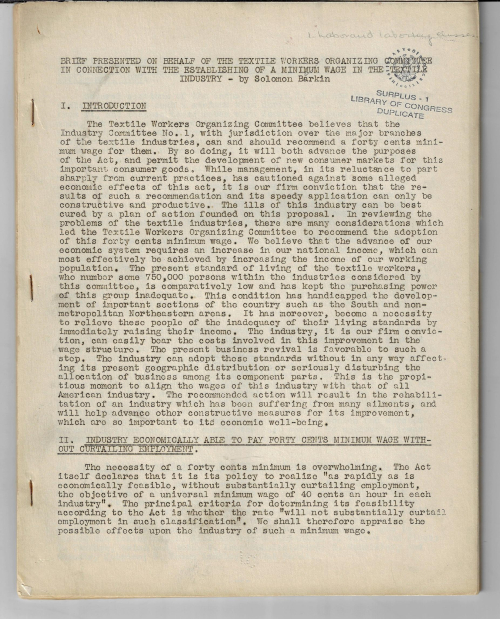(40 cents in 1939=Federal minimum wage in 2018)
 Solomon Barkin (1908-2000), "Brief Presented on Behalf of the Textile Workers Organizing Committee in Connection with the Establishing of a Minimum Wage in the Textile Industry." The Textile Workers Organizing Committee, 1939. 11x8.5”, 43 leaves (28 paginated plus 15pp of interleaved appendix pages). Offset production from typed original. Provenance: presented by the Textile Committee to the Library of Congress. Condition: small (6mm) perforated “LC” stamp at front page bottom; LC surplus rubber stamp at top right. Rare. $150
Solomon Barkin (1908-2000), "Brief Presented on Behalf of the Textile Workers Organizing Committee in Connection with the Establishing of a Minimum Wage in the Textile Industry." The Textile Workers Organizing Committee, 1939. 11x8.5”, 43 leaves (28 paginated plus 15pp of interleaved appendix pages). Offset production from typed original. Provenance: presented by the Textile Committee to the Library of Congress. Condition: small (6mm) perforated “LC” stamp at front page bottom; LC surplus rubber stamp at top right. Rare. $150
Coming a few years after what was basically the end of the New Deal as a result of a better economic climate, the textile worker reps were organizing around the minimum wage for the basic worker at 40 cents per hour. The idea behind the minimum wage would be beneficial to both worker and industry—it would allow more buying power resulting in more sales for industry.
Adjusting for inflation, using the Bureau of Labor Statistic inflation calculator, 40 cents in 1939 would be about $7.09, which is very close to the current $7.25 federal minimum wage in 2018. The first federal minimum wage was set at 25 cents/hour in 1938, and then to 30 cents in 1940, 40 cents in 1945, and then 75 cents in 1950, which would be about $7.70 in 2018 dollars. This is the start of a period 26 years in which the contemporary minimum wage was higher than the minimum wage is now, adjusting for inflation. After the increase to $3.85 in April 1990 under Bush I, the minimum has been slightly sinusoidal above-and-below the current minimum—basically remaining very little changed in purchasing power for the last 28 years, and 20% or more weaker than the minimums from 1956-1990.
The Barkin document is a compelling evidentiary presentation of the benefit to the textile industries in paying a higher minimum wage to its workers.
“Professor Barkin spent 25 years in the labor movement, from 1937 to 1963, as director of research for the Textile Workers Union, now part of the Union of Needletrades, Industrial and Textile Employees. For the next five years, he was a manpower specialist and head of the social-affairs division of the Organization for Economic Cooperation and Development in Paris. He taught economics at Amherst from 1968 to 1978, when he was given emeritus status. Then he was a visiting professor of economics at Erasmus University in Rotterdam, the Netherlands, and a senior Fulbright professor at Victoria University in Wellington, New Zealand.”--NYTimes obituary for Mr. Barkin.




Comments